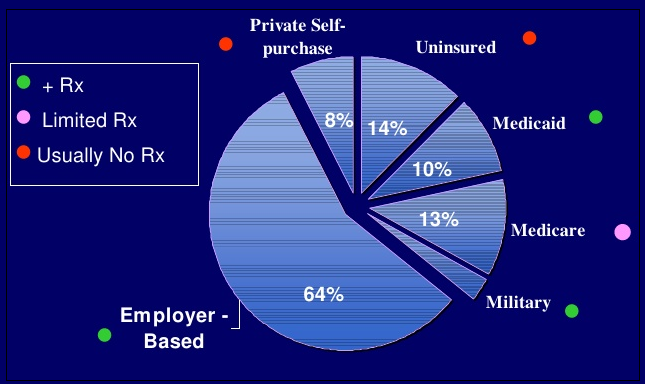The healthcare system of a given country dictates the quality of medical services available to its citizens. The United States and Canada have adopted diverse models and policies to ensure that more people have access to superior care. This paper compares and contrasts the health care systems of these two nations.
Comparing and Contrasting the U.S. and Canada Health Care Systems
The passage of the Canada Health Act in 1984 resulted in a superior system for delivering high-quality medical services. This model allows the government to use federal standards to meet the health demands of different populations (Morgan & Boothe, 2016). There are private entities that offer targeted medical services or care. Members of the public can enroll in the existing program whereby the government uses income taxes to cater to costs (see Figure 1).
Provincial programs meet the needs of around 71 percent of the population (Morgan & Boothe, 2016). The system also creates room for employment-based health insurance and public funds for pharmaceutical medications. These aspects reveal that Canada has a single-payer health care system.

The situation is quite different in the United States since it has a multilayer model. This is true since there are specific organizations and facilities aimed at meeting the medical needs of different American citizens. The majority of the facilities are private entities while 28 percent are owned by the government (Dickman, Himmelstein, & Woolhandler, 2017). The government utilizes public health coverage to meet the needs of different citizens, such as Medicaid and Medicare (see Figure 2). It also provides medical insurance to employees working in various organizations.

From this analysis, it is evident that there are unique similarities in these two healthcare systems. Firstly, both governments use income taxes to provide health insurance to its citizens. Secondly, there are public programs implemented to improve the health outcomes of the targeted beneficiaries. Thirdly, these countries have controlled models aimed at meeting the demands of every needy citizen (Morgan & Boothe, 2016). Wait time is a common challenge in these two regions.
However, unique differences are existing in these two countries. For instance, the Canadian system has a model that promotes coverage for both private and public delivery while that of the United States limits funding to Medicaid, State Children’s Health Insurance Program, and Medicare. Another one is that the US government incurs increased health costs while Canada’s expenditure is low. Dickman et al. (2017) go further to indicate that 40 percent of Americans lack sustainable insurance while around 5 percent of Canadians do not receive quality care. The US government can consider these insights to make superior decisions.
Recommendations
In the future, states and policymakers should engage in discussions that have the potential to improve this country’s healthcare system. They can begin by considering the most appropriate ways to introduce superior programs that can increase the number of people with health insurance. A new system whereby the government centralizes the allocation of funds will increase coverage to over 96 percent (Dickman et al., 2017). Such initiatives will eventually result in reduced health disparities.
Conclusion
The above discussion has revealed that there are unique similarities between the healthcare systems of the United States and Canada. The existing differences explain why the US government can emulate the Canadian model to minimize the number of citizens who cannot access high-quality medical services. It can also identify evidence-based initiatives that have worked elsewhere to improve the current healthcare system.
References
Dickman, S. L., Himmelstein, D. U., & Woolhandler, S. (2017). Inequality and the health-care system in the USA. The Lancet, 389(10077), 1431-1441. Web.
Morgan, S. G., & Boothe, K. (2016). Universal prescription drug coverage in Canada: Long-promised yet undelivered. Healthcare Management Forum, 29(6), 247-254. Web.
Valle, V. M. (2016). An assessment of Canada’s healthcare system weighing achievements and challenges. Norteamérica, 11(2), 193-218. Web.